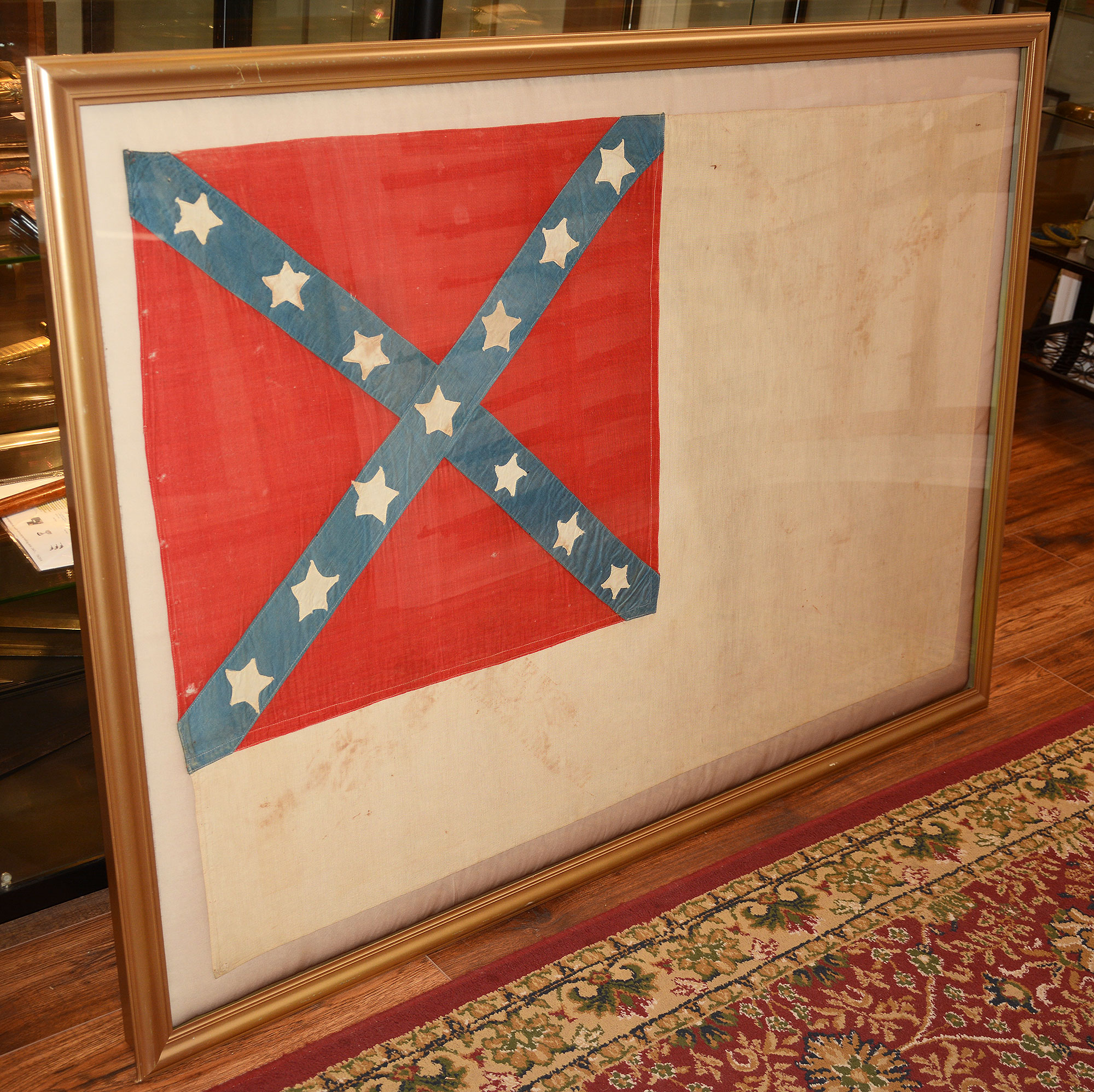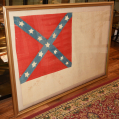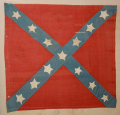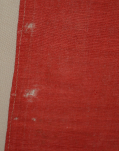site search
online catalog
CAPTURED CONFEDERATE SECOND NATIONAL FLAG, UNUSUAL VARIATION WITH MADAUS LETTER, FROM A SOLDIER IN THE 59th NEW YORK

$65,000.00
Quantity Available: 1
Item Code: 1179-019
Shipping: Determined by Method & Location of buyer
To Order:
Call 717-334-0347,
Fax 717-334-5016, or E-mail
This 2nd National Confederate Flag was purchased in the 1980s by a well-respected Florida dealer/collector directly from descendants of the Union soldier who had kept it as a trophy. It comes with a 1988 letter on Milwaukee Public Museum letterhead from Howard Madaus, the well-known scholar on Confederate flags, as well as 1990 conservation reports (both treatment proposal and report, with recommendations for handling and exhibit) by Fonda Thomsen, another well-known name in the field, written for the Texas Civil War Museum, from whose collections it now comes.
The second pattern for national flag for the Confederacy, something looking less like the stars-and-stripes, was adopted May 3, 1863, after some debate on a design using the Confederate battle flag as a canton on a white field. The latter was given various symbolic interpretations by supporters, and regarded with some practical reservations by detractors such as the possibility of it being mistaken for a flag of truce or simply that it was subject to soiling. It had, though, already been used by Confederate navy as a battle ensign and with some changes in proportions it was adopted by the Confederate congress and used for almost two years, before being officially changed in March 1865 by the addition of a vertical red stripe at the end.
The flag measures 35 by 50 3/8” with the canton 25” on the staff and 26” on the fly. The blue cross is 2 7/8 inches wide, and has 13 five-pointed stars, each 2 ¼ by 21 ½” and shows some small holes on the lead edge from having been nailed to its staff (Madaus.) The conservation report adds details: the flag consists of an off-white cotton fly with a single layer of red fabric inserted in the upper left corner to form a canton; the stars were basted to the blue cross and then machine sewn with the edge rolled in; the cross was then appliqued to the canton without a white border (fimbration) and the leading and fly edges were hemmed. The report states that the flag “is intact with no major damage,” noting just some weak areas along the top of the canton; some red-brown stains on the fly to the right of the canton and below it, matching the shape of the canton cross, likely resulting from contact with it when folded; and the small holes along the leading edge, with one in the bottom quadrant of the canton. The stains are very thin and are not obtrusive. The report also contains detailed analysis of the fabric and thread, notes it was machine sewn throughout, and that, “the materials used in the construction of the flag and present condition concur [sic] with its reported history.” The full report and additional photos can be supplied to interested parties, but the main treatment was light cleaning, neutralizing pH, and mounting for conservation and display.
Madaus provided three parallels for the flag, differing mainly in the material of the cross and diameter of the central star, which is the same as the others on this flag rather than being slightly larger, and that he thought were close enough to indicate this, like those, had been captured in the eastern theatre of the war in 1864-65 in the Richmond-Petersburg-Appomattox campaign. One of those three was specifically captured at Petersburg April 3, 1865, by an officer of the 20th Michigan. More recent scholarship and study have likely turned up other examples as well.
The flag itself was acquired from descendants of Charles Strewing, who enlisted as a substitute in July 1863 and served to July 1865 in eastern theatre, putting him in the right place and right time by Madaus’s analysis to have acquired it. Strewing’s service and pension records from the National Archives are in included in the file with this flag. He claimed to have had prior service under an alias in the 9th New Jersey, which is unsubstantiated, but he shows up in the 42nd New York until it was mustered out at the end of its term of service and he, having enlisted for three years, was briefly transferred to Co. H of the 82nd NY (as Charles Strawing) on June 28, and then along with others from that unit not entitled to a discharge, consolidated with the 59th NY, making Strewing officially part of Co. H in that regiment as of July 10, 1864.
Strewing had seen action with the 42nd in Fall 1863, being wounded at Bristoe (Bristow) Station on October 14, 1863, and hospitalized at least until late November, but claimed to have rejoined the regiment at Culpepper in Spring 1864 in time to take part in the Battles of Wilderness, Spotsylvania (where he claimed to have suffered a head-wound from a rifle butt, Cold Harbor and Petersburg, where as a member of the 59th NY he was taken prisoner in October, purportedly at Weldon Railroad. He was paroled in February 1865 at Aiken’s Landing in Virginia, and was then in hospital at Camp Parole until April 13 when he was sent to the regiment, but hospitalized again by April 16 at the Sickles Barracks Hospital from the effects of Scrofula and Scurvy during his imprisonment, and does not seem to have returned to the regiment before mustering out July 21, 1865. Given Madaus’s dating of the flag, this does not give him much opportunity to have acquired it in the field, but he likely got it from a comrade who did, either then or later as a member of Wallace G.A.R. Post 95 in Flat Rock, Michigan. A copy photo supplied by the family with flag shows him among fellow veterans of that post (and with his daughter.) He died in 1934, likely making him one of the last survivors of the post and perhaps inheritor of its artifacts. A signed typewritten letter by a granddaughter, who passed away only in 2000, well after the family sold the flag, says that he, “cherished many trophies and war pictures, among them were this Thirteen Star Confederate Flag, and Drum and sticks,” sounding very much as if he was custodian of more than his personal mementos.
This is a very good-looking Confederate Second National in an interesting, recognized variation, with good provenance and documentation, conserved, framed, and ready to hang. Sometimes referred to as the Jackson Flag, one of its first official public appearances was draped over the coffin of Stonewall Jackson in May 1863. It was an ironic twist for a new emblem of what was hoped to be a new nation that its debut was at the funeral of the general whose fall many later regarded as the beginning of its end. [sr] [ph:L]
SPECIAL SHIPPING ARRANGEMENTS REQUIRED
~~~~~~~~~~~~~~~~~~~~~~~~~~~~~~~~~~~
THIS ITEM, AS WITH ALL OTHER ITEMS AVAILABLE ON OUR WEB SITE,
MAY BE PURCHASED THROUGH OUR LAYAWAY PROGRAM.
CLICK HERE FOR OUR POLICIES AND TERMS.
THANK YOU!
Inquire About CAPTURED CONFEDERATE SECOND NATIONAL FLAG, UNUSUAL VARIATION WITH MADAUS LETTER, FROM A SOLDIER IN THE 59th NEW YORK
For inquiries, please email us at [email protected]
Most Popular
Historical Firearms Stolen From The National Civil War Museum In Harrisburg, Pa »
Theft From Gravesite Of Gen. John Reynolds »
Cavalry Carbine Sling Swivel »
Fine Condition Brass Infantry Bugle Insignia »
featured item
GERMAN SILVER BUGLE AND DISCHARGE OF BEVERLY W. MUSSELMAN, COMPANY MUSICIAN AND PRINCIPAL MUSICIAN: 13th PA Militia, 178th PA, 210th PA. MENTIONED IN A 1915 COUNTY HISTORY
This German silver bugle is made with a double-coil tube fitted with ferrules joining the sections and has a bell garland. It matches very closely a horn made by Joerdans of NY, illustrated as Figure 10 in Chris Nelson’s classic article on Civil… (2023-2833). Learn More »






